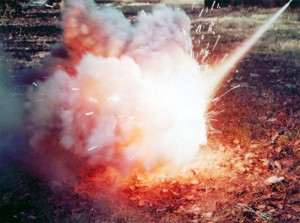Halon is one of the most effective fire suppression agents available today. It can be used for Class A, B and C fires with great effect. When it comes to Class D fires however; Halon should never be used. Class D fire are those that involve metals like sodium, potassium, titanium, magnesium and lithium. Lithium is common in many newer batteries as well as older camera batteries. The FAA conducted tests regarding these types of batteries and the application of Halon. Different metals will react more or less energetic with Halon depending on how active the metal is. Sodium reacts quite violently with Halon 1301. Battery fires have been linked to multiple aircraft fires inside cargo compartments. Guidelines for the transportation of primary cell lithium batteries require that battery shipments must be located in cargo compartments with fire suppression systems. Unfortunately nearly all of these systems utilize Halon as the suppression agent.
The Ventura Aerospace fire suppression system uses a different approach to fight fires. Rather than flood an entire compartment with suppression agent, the fire is located inside the compartment and then suppressed. The system uses an Argon based foam solution called Cargo Foam. This agent was developed by Ansul has been specifically designed for use on aircraft. During the development of Cargo Foam live fire testing was conducted on the FAA deep seated standard fire. This is one of the most challenging fires to suppress. Cargo Foam was very successful in suppressing this type of fire. As paper products are not the only thing carrier in cargo aircraft testing was conducted on various hazardous materials. Class D metals are some of the most hazardous. Not only will the metal burn but the transport of the metal is usually inside a vessel with a flammable fluid. This keeps the metal being exposed to water. Cargo foam was tested on various metals and ultimately on bulk package primary cell lithium batteries. Here is a video of that testing. Bulk Load Lithium Batteries

When Halon is applied to a burning metal such as Sodium the reaction is quite violent.
